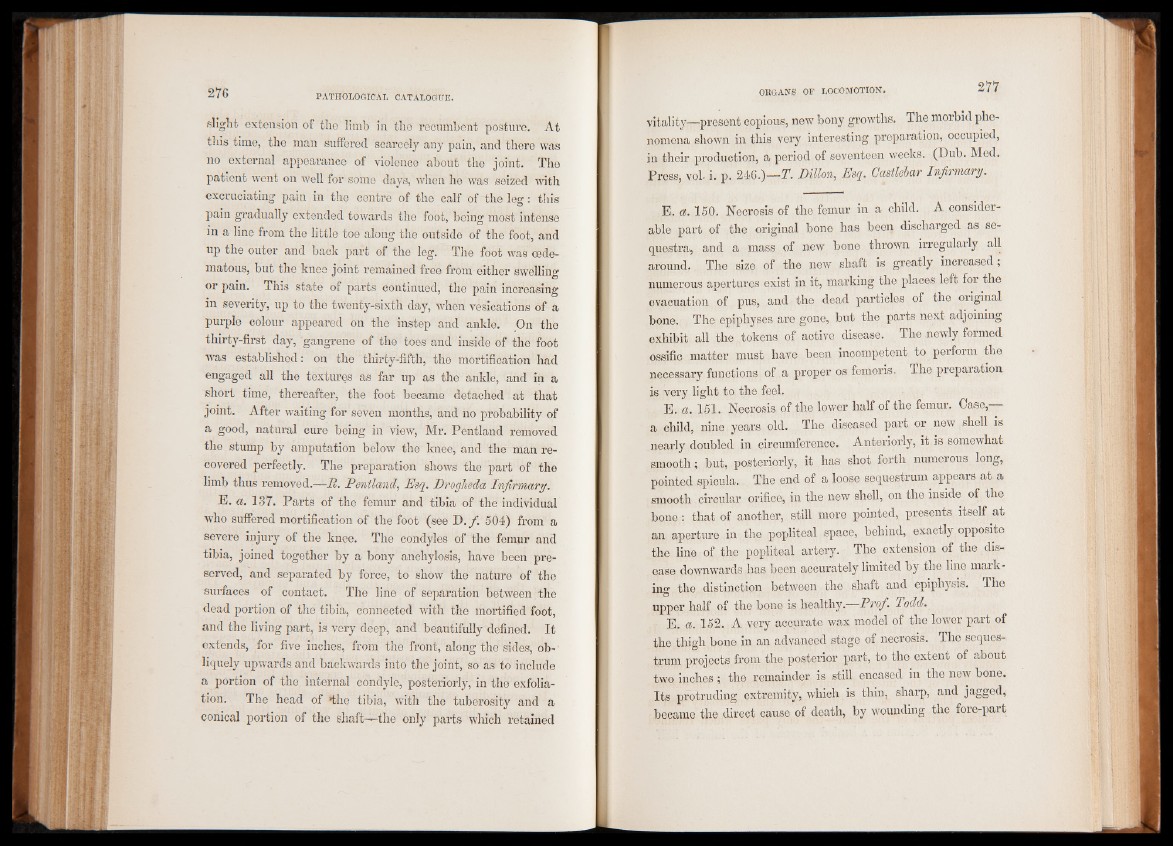
slight extension of the limb in the recumbent posture. At
this time, the man suffered, scarcely any pain, and there was
no external appearance of violence about the joint. The
patient went on well for some days, when he was seized with
excruciating pain in the centre of the calf of the leg: this
pain gradually extended towards the foot, being most intense
in a line from the little toe along the outside of the foot, and
up the outer and back part of the leg. The foot was cede-
matous, but the knee joint remained free from either swelling
or pain. This state of parts continued, the pain increasing
in severity, up to the twenty-sixth day, when vesications of a
purple colour appeared on the instep and ankle. On the
thirty-first day, gangrene of the toes and inside of the foot
was established: on the thirty-fifth, the mortification had
engaged all the textures as far up as the ankle, and in a
short time, thereafter, the foot became detached at that
joint. After waiting for seven months, and no probability of
a good, natural cure being in view, Mr. Pentland removed
the stump by amputation below the knee, and the man recovered
perfectly. The preparation shows the part of the
limb thus removed.—Tt. Pentland, Esq. Drogheda Infirmary.
E. a. 137. Parts of the femur and tibia of the individual
who suffered mortification of the foot (see D. f. 504) from a
severe injury of the knee. The condyles of the femur and
tibia, joined together by a bony anchylosis, have been preserved,
and separated by force, to show the nature of the
surfaces of contact. The line of separation between the
dead portion of the tibia, connected with the mortified foot,
and the living part, is very deep, and beautifully defined. It
extends, for five inches, from the front, along the sides, obliquely
upwards and backwards into the joint, so as to include
a portion of the internal condyle, posteriorly, in the exfoliation.
The head of *the tibia, with the tuberosity and a
conical portion of the shaft—the only parts which retained
vitality—present copious, new bony growths. The morbid phenomena
shown in this very interesting preparation, occupied,
in their production, a period of seventeen weeks. (Dub. Med.
Press, voL i. p. 246.)—T. Dillon, Esq. Castlebar Infirmary.
E. a. 150. Necrosis of the femur in a child. A considerable
part of the original bone has been discharged as sequestra,
and a mass of new bone thrown irregularly all
around. The size of the new shaft is greatly increased;
numerous apertures exist in it, marking the places left for the
evacuation of pus, and the dead particles of the original
bone. The epiphyses are gone, but the parts next adjoining
exhibit all the tokens of active disease. The newly formed
ossific matter must have been incompetent to perform the
necessary functions of a proper os femoris. The preparation
is very light to the feel.
E. a. 151. Necrosis of the lower half of the femur. Case,—
a child, nine years old. The diseased part or new shell is
nearly doubled in circumference. Anteriorly, it is somewhat
smooth; but, posteriorly, it has shot forth numerous long,
pointed spicula. The end of a loose sequestrum appears at a
smooth circular orifice, in the new shell, on the inside of the
bone : that of another, still more pointed, presents itself at
an aperture in the popliteal space, behind, exactly opposite
the line of the popliteal artery. The extension of the disease
downwards has been accurately limited by the line mark-
ing the distinction between the shaft and epiphysis. The
upper half of the bone is healthy.—Prof. Todd.
E. a. 152. A very accurate wax model of the lower part of
the thigh bone in an advanced stage of necrosis. The sequestrum
projects from the posterior part, to the extent of about
two inches; the remainder is still encased in the new bone.
Its protruding extremity, which is thin, sharp, and jagged,
became the direct cause of death, by wounding the fore-part